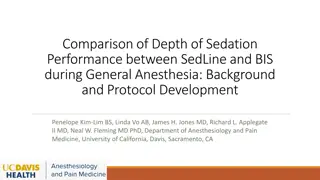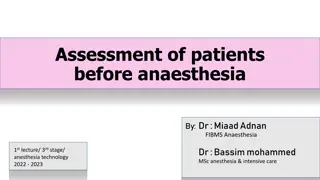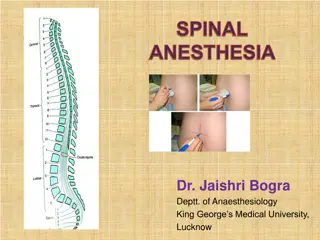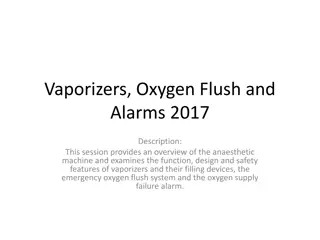Local Anesthetic and Analgesic Techniques
Local anesthetics are compounds that block nerve impulses, providing temporary pain relief without loss of consciousness. They are essential for surgeries and pain management, offering benefits in avoiding general anesthesia and providing sustained analgesia.
Download Presentation

Please find below an Image/Link to download the presentation.
The content on the website is provided AS IS for your information and personal use only. It may not be sold, licensed, or shared on other websites without obtaining consent from the author.If you encounter any issues during the download, it is possible that the publisher has removed the file from their server.
You are allowed to download the files provided on this website for personal or commercial use, subject to the condition that they are used lawfully. All files are the property of their respective owners.
The content on the website is provided AS IS for your information and personal use only. It may not be sold, licensed, or shared on other websites without obtaining consent from the author.
E N D
Presentation Transcript
Local Anesthetic and Analgesic Techniques
Local anesthetics are a group of chemically related compounds that reversibly bind sodium channels and block impulse conduction in nerve fibers. Local anesthetics produce a transient and reversible loss of sensation (analgesia) in a circumscribed region of the body without loss of consciousness
Purpose of local anesthesia The use of a local anesthetic is essential if surgery is to be performed in a conscious patient and the pain associated with trauma and inflammation is to be relieved. The use of a local anesthetic technique before surgery may also benefit patients by avoiding general anesthesia or reducing the amount of required general anesthetics. Sustained analgesia into the recovery period is a great benefit to patients when a local anesthetic with a longer anesthetic effect is used.
Classification of locoregional anesthesia 1. Topical or surface anesthesia the transmission of sensory information can be blocked before it starts at the site of a superficial injury. Unfortunately, most local anesthetics are not readily absorbed across the skin surface, and special formulations are needed for them to be used in this way. mixtures of local anesthetics comprised of 2.5% lidocaine and 2.5% prilocaine formulated as a cream have been used to decrease pain for a variety of dermal procedures in people and has been studied in cats minimize pain associated with jugular puncture. These creams are indicated for dermal anesthesia and have been reported to be useful for preventing pain associated with percutaneous intravenous catheter placement, blood sampling, and superficial skin closure in people.
1. Topical or surface anesthesia When used according to directions, the cream is applied to the skin and covered with an occlusive dressing to facilitate absorption of the local anesthetics. Local anesthetic efficacy is achieved after approximately 60 min and lasts for up to 2 h Clinical trials in people have demonstrated that lidocaine patches placed near the site of incision can produce prolonged dynamic pain control and reduce the amount of systemic opioids required for postoperative analgesia
2. Infiltration anesthesia Infiltration anesthesia involves the injection of local anesthetic solution into and around the planned surgical field, not specifically targeted near any particular nerve or nervous system structure. Many use the term local anesthesia as a synonym for infiltration anesthesia, although strictly speaking topical anesthesia would also be a form of local anesthesia.
2. Infiltration anesthesia Several studies have reported incision infiltration in dogs and cats. Development and use of wound infusion catheters have taken this technique a step further, allowing the continuous or intermittent delivery of local anesthetics into tissues surrounding surgical wounds without the need for repeated needle penetration for injection of analgesic drugs
3. Regional or nerve (plexus) block anesthesia Regional anesthesia refers to the injection of a local anesthetic solution adjacent to a peripheral nerve to temporarily block conduction and therefore sensory afferent and/or motor efferent activity in the anatomic region innervated by the nerve(s). These techniques are commonly used to provide intra and postoperative analgesia in many parts of the body, including the head, limbs, and trunk
4. Neuraxial anesthesia The administration of agents with anesthetic and/or analgesic properties via epidural or spinal routes can be effective at relieving pain Epidural anesthesia refers to the administration of drugs (usually a local anesthetic solution) into the epidural space, whereas the administration of a drug into the subarachnoid space is known as spinal, subarachnoid, or intrathecal anesthesia. Opioids and other classes of analgesic agents can be administered by this route
4. Neuraxial anesthesia The site of action of drugs deposited in the epidural space is mainly the nerve roots as they leave the spinal cord and travel out from the intervertebral foramina. Dorsal and ventral spinal root transmission becomes inhibited when these structures are bathed by the local anesthetic solution Drug access to the site of action is largely dependent on the drug s physical and chemical properties, its effects with membranes that cover and protect the nervous tissue, volume of drug administered, and gravitational concentration dependent distribution of the solution
5. Intraarticular analgesia Local anesthetics, opioids, steroids, and other adjuvants are commonly administered into joints as a means of providing intra articular analgesia. Intra articular injection of local anesthetic provides analgesia for intra articular structures only, and will not prevent pain arising from extra articular structures such as subchondral bone, extra articular soft tissue, or skin.
Intraarticular analgesia Recently, attention has been drawn to the possible toxic effects of local anesthetics on chondrocytes. Based on clinical experience, a single injection of low concentration bupivacaine solution appears to be safe, and the chondrotoxic effects of a single intra articular bupivacaine appear significant) and are unlikely to be detected clinically, injection minor of statistically 0.5% (but
Intraarticular analgesia Repeated administration of bupivacaine via indwelling intra articular catheters has been associated with chondromalacia and should be avoided Ropivacaine is less chondrotoxic than bupivacaine and mepivacaine appears to have negligible effects in vitro and is, therefore, the drug of choice of many for intraarticular administration. Since the discovery of opioid receptors on peripheral nerves and in joints, several studies have described the analgesic effect of opioids (mainly morphine) after arthroscopy or joint surgery in humans. Low doses of intra articular morphine will significantly reduce pain after knee surgery through an action on local opioid receptors that reaches its maximum effect 3 6 h after injection
(a) A needle has been placed into the elbow joint on the medial aspect of the left thoracic limb of a dog that is positioned in dorsal recumbency. (b) A needle is being placed into the right scapula humeral joint of a dog that is positioned in the left lateral recumbency.
6. Intravenous regional anesthesia (IVRA) Also referred to as a Bier block, IVRA involves administration of a local anesthetic into a peripheral vein, where it is distributed to the tissues served by the local venous drainage, and provides surgical anesthesia for up to 90 min. Prior to drug administration, the limb is elevated and wrapped in a tight bandage. A tourniquet is then applied proximal to the injection site, and the local anesthetic is injected into a vein.
6. Intravenous regional anesthesia (IVRA) The tissues distal to the tourniquet will be desensitized. Care must be taken so that limb ischemia time is kept at a minimum to avoid tissue damage. Additionally, early release of the tourniquet may result in transient increases in local anesthetic plasma concentrations, which can result in central nervous and myocardial system toxicities.
7. Thoracic blocks Selective intercostal nerve block and infusion of local anesthetics into the interpleural space are the primary means of providing analgesia for thoracic procedures in dogs and
Intercostal nerve blockade involves injection of a local anesthetic solution adjacent to several contiguous intercostal nerves, for dogs undergoing a variety of thoracic surgical procedures. Interpleural analgesia involves deposition of a local anesthetic solution into the pleural space that exists between the parietal and visceral pleurae, useful for providing pain relief not only for thoracic surgeries, but also for painful disorders of the cranial abdomen (e.g., pancreatitis)
The common Types of blocks Nerve blocks: If we know where the nerve is, we can just put local anesthetic near the nerve. Eg dehorning blocks and paravertebral blocks Line blocks: Local anesthetic is injected in the line of the planned incision. This does deform the tissue planes but is the easiest to control Field blocks: The nerves to a region are blocked using specific types of line blocks. An L block is used in the flank to block the regional paravertebral nerves. Ring blocks: A specific type of field block. The entire limb is encircled with subcutaneous local anesthetic to reach any and all nerves
Line block A line block is an injection of subcutaneous lidocaine along the site of the incision The block can be easier on the animal if a longer needle is used and is inserted through the site of the last injection. This minimizes the number of pokes in unblocked skin. For flank incisions, it is important to also place lidocaine deeper in the muscle layers. The main disadvantage of a line block is distortion of the surgery field
Inverted L block block is similar to the line block but is used to block the nerves as they come down the flank and avoids lidocaine directly in the surgery field. The lidocaine is injected in two long lines one just behind the last rib and one below the transverse processes of the vertebrae. The injection must be deep enough to get the deeper nerves and typically does not block the peritoneum.
Proximal paravertebral block For this block, the spinal nerves T13, L1 and L2 are blocked as directly as possible as they exit the spinal cord. This creates a more effective block. When the block is working, the cow will bend toward the opposite side as muscles are relaxed. At each site, ~20 ml of lidocaine is injected. Needles are inserted above the transverse processes T13, L1 and L2 and walked off the dorsal margin of each bone. A long needle is used to block the nerve branches both above and below the fascia. This block can be challenging in very large beef breeds due to difficulty palpating landmarks.
Distal paravertebral block This block is also aimed at spinal nerves T13, L1 and L2 but is coming at them from a more distal position. As the nerves traverse caudally, the injection sites are at the tips of L1, L2 and L4. At each site, 10-20 ml of lidocaine is injected.
Local anesthetics Chemical structure Clinically useful local anesthetic drugs are composed of a lipophilic, benzene ring with different substitutions (aromatic ring) and a hydrophilic amine group (tertiary or quaternary amine), which are linked through an intermediate chain, either an ester or an amide. ( ) ) ( . Depending on the type of link, local anesthetics are classified as amino esters, hydrolyzed by plasma cholinesterases, or aminoamides, metabolized by the liver. The physicochemical properties influencing local anesthetic activity include molecular weight, pKa, lipid solubility, and degree of protein binding
The ideal of local anesthetic drug Non irritant Non allergic reaction No systemic toxicity Rapid onset of action Sufficient duration of action Potent Stable in solutions Not interfering with healing of tissue Have a vasoconstrictor action Not expensive























